An All-Wild Quail Hunt at Guitar Ranch in Spur, Texas
The first pointer locked up, the second honoring him, which meant I was moments away from getting a snootful of West Texas dirt.
I’m about 50 miles east of Lubbock on the Guitar Ranch where cattle-punching cowboys seem to be born from the terrain of prickly pear and tasajillo cactus, cedar bushes, mesquite trees and the elegant silver-blue side oats grama grass leaning into the 37-mile-per-hour winds that morning. Although the ranch in Spur, Texas scientifically grooms the terrain for hunting quail, dove, sand crane, goose, ducks, feral hogs, mule deer and turkey across some 20,000 acres, Phil Guitar, owner and operator of Guitar Ranches (which manages ranches across six counties in Texas that combined host about for 75,000 acres for hunting and fishing) adamantly told me from his office in downtown Abilene, “Guitar Ranch is not a dude ranch and never will be.”
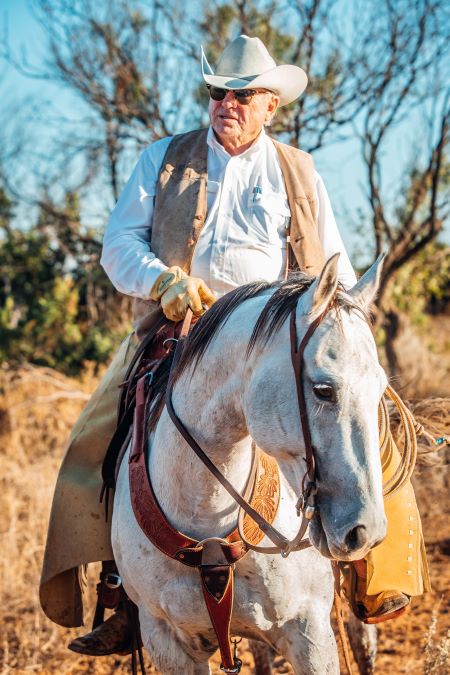
Phil Guitar
I was pleased to hear it. Away from the computer for a few days, I’m glad to be here because no boy ever grew up playing farmers and Indians, and I really need a jolt of authentic adventure.
Now in the field, following the dogs in our Mule, the morning sky of gunmetal gray prevailed from waves of cold fronts sweeping through the West and Midwest. The weather made for challenging wingshooting – at least for a South Georgia transplant like me accustomed to the gentlemanly pursuit of the six-ounce bird from the perch of a mule-drawn buggy under a canopy of loblolly pines. At an elevation of 2,500 feet, the temperature is 31 with the wind shear making it feel like 19. If you’ve ever been to a dermatologist who sprayed liquid nitrogen on your face, you get the general idea. Regardless, sitting in the luxe four-seater Mule, the heater blowing high, my hunting companions are rarinʹ to shoot wild quail.

Mike Stephens
Behind the wheel is venerable Mississippi dog trainer and guide, Mike Stephens, of Stephens Kennels, who migrates to Guitar Ranch during quail season that starts late October or early November and runs through the last weekend in February.
My other hunting companion is Matt Nelson. He’s a local boy. Through real-estate dealings between his father and the Guitar family, Matt has known them for decades. Matt is everywhere at once. He recently started importing and distributing the British legacy over/unders of Webley & Scott, now made in Turkey. We’re shooting his new Webley & Scott 20/28 Combo over/under that relies on the 20-gauge frame. Otherwise, Matt is on the phone trading bird dogs, with a soft spot for liver-headed pointers and cockers; he’s a competitive sporting-clays shooter; he’s a rancher; he guides for Guitar Ranch; and he’s a family man. In fact, I had found myself in a jam and he proved to be an incredibly considerate and kind person always willing to help another even if it means going far out of the way (easy to do in Texas).
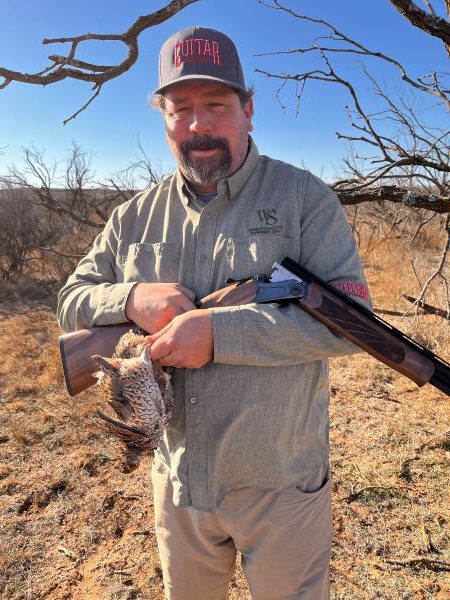
Matt Nelson
My first day of the visit involved shooting the ranch’s sporting clays course, but today we’re hunting wild quail in wild weather. Our schedule is hunt in the morning, back to the dining hall for lunch then out again for our second hunt, capped by dinner. On the third day I return home to a different variety of quail hunting – the lush, plantation-rich Red Hills Region around Thomasville, Georgia.
“Ready?” says Mike.
Opening the passenger door, the wind slams it into the Mule and damages the hinge. I’m momentarily weather-shocked, but seeing Mike and Matt marching towards the dogs I hurry to catch up. We all know the perils of rushing towards a dog on point: carrying a shotgun, watching the ground for potential trips and falls, while keeping an eye on the dogs and fellow hunters. Hunting wild quail at Guitar Ranch, however, something else requires your attention: big blobs of cow dung everywhere – and they’re not from feral cows.
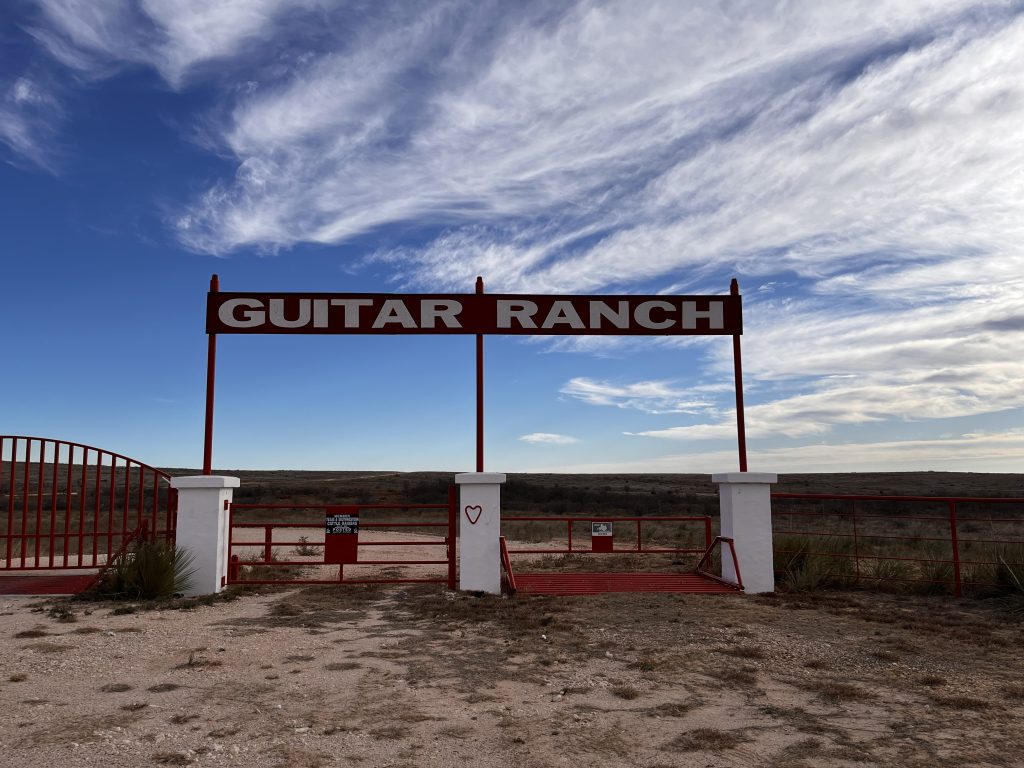
Getting ready to enter Guitar Ranch.
Lloyd LaCoste, Wildlife Manager at Guitar Outdoors at Guitar Ranch, explained the cowboy alternative to prescribed burns, which he knew in-depth from working 10 years at the revered Rolling Plains Quail Research Foundation.
“Moving the cattle around we do rotational grazing, and having the proper stocking rate to promote the grasses is critical” he said. “We’re always shooting for a nice balance between grasses that protect the birds and forb – the seeds that the quail eat.” He also talked about the specialty bird-seed spreaders used to supplement the quails’ natural food sources.
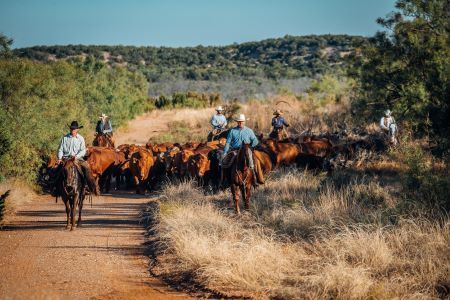
Guitar Ranch moves around their herd of cattle instead of prescribed burns to maintain the quail habitat.
With 1,400 head of cattle on Guitar Ranch, the process requires constant attention because when cow eat grass they disturb the soil and the subsequent regrowth of grass suppresses the forbs.
“The cattle replace burns,” he said. “Our annual rainfall might be 15 inches. We can’t burn every year. We burn maybe once every 10 years.”
Lloyd told me that many of the coveys flush from cedar bushes. Sure enough, a single quail rose from one, flying into the wind. I nailed it with the Webley & Scott 20 gauge. Examining the bird later, it was plump and healthy.
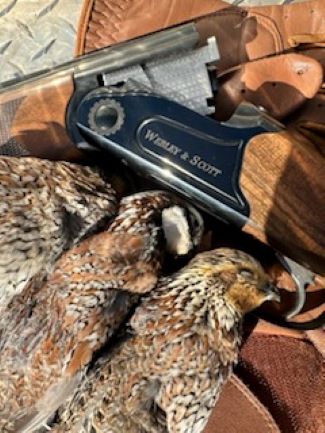
A few of the quail taken with the Webley & Scott Combo over/under.
I marked the downed quail, heading to Matt and Mike when on the other side of a mesquite-tree cluster the dogs raised a covey that scattered like crazy. Matt focused on one, hitting it with the 28-gauage barrels of a Webley & Scott Combo.
Leading up to lunch, the dogs flushed 10 coveys of between 10 and 25 birds each. Those birds flew like rockets. I understood why Mike had said he trains his dogs only for wild birds. While I continued missing in the wind, Matt downed at least one bird in each covey with quick, lethal shots. He showed himself as the epitome of instinctive shooting.
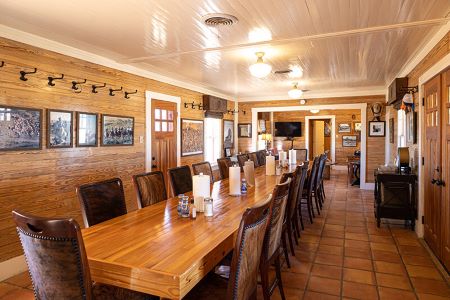
The Guitar Ranch dining hall.
When it comes to quail hunting, particularly in the South, authenticity often gives way to theater. Wild plantation quail are scarce and can cost thousands per day. Otherwise, coughing up enough money will get you mule-drawn wagons with rubber tires. The quail are pen-raised. The plush lodge seems like a stage set. And dinner is overly ambitious given the local culinary talent. It’s all an effort to replicate the aristocratic plantation homes of the Reconstruction Era, but with a commercial flourish. At Guitar Ranch, you leave those pretentions behind because we’re enjoying lunch in a long, narrow dining hall that is a refurbished bunk house when in walks James “Jimbo” Humphreys, Jr.
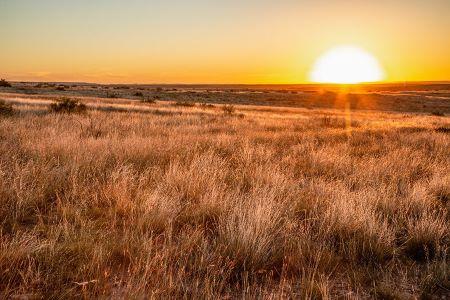
Some of the prime Texas quail habitat at Guitar Ranch.
For a Yankee like me, Jimbo was everything you’d expect in a cowboy. He’s tall and long-limbed sporting a silver Fu Manchu moustache and cowboy hat. Jimbo was the 2023 recipient of the Ranching Heritage Association (RHA) Working Cowboy Award that recognizes all aspects of ranch work. Having worked on Guitar Ranch for 32 years, he’s punched cows, cooked on chuckwagons, trained horses, built fences and corrals and now, manages the large cow-calf operation on the ranch – all of etched on his weathered face. He quietly approached Miss Melisa at the kitchen pass-through, a quick chit-chat and then sat opposite me where he ate in a holy silence. Phil Guitar insists that people working on his ranch shouldn’t go hungry and can stop by for a meal anytime during serving hours – giving you the chance to strike up a conversation and understand the authentic cowboy ranch life with the guys who actually refer to the building by its 1930s name “cook shack.”
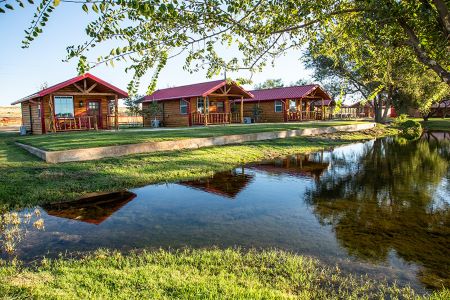
Guest cabins at Guitar Ranch.
After lunch, we got lucky. The wind had subsided, opening blue breaks in the cloud cover that let the sun warm us. With the Mule idling in front of the dining hall, Mike and Matt discussed some promising locations with big coveys. They agreed on one spot closer to water on a mesquite mesa. Over the next three hours on the arid landscape, we would flush five coveys that exploded with a mindblowing 40 to 50 birds – making for the most exhilarating upland hunt ever.
Later, I returned to my cabin. Completed in the early 2020s, it was with other construction projects that included a lodge and seven rustic guest rooms/cabins.
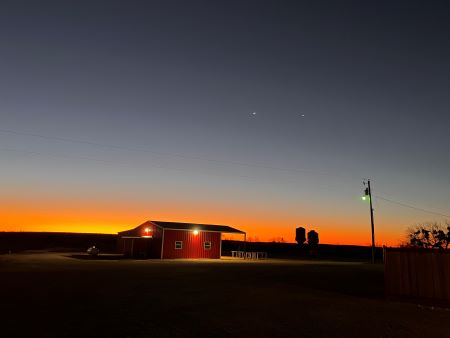
Sunrise on Guitar Ranch.
Cook Ruby Crumbs had been off that night. Mike fired up the grill. Four guys, Mike’s friends from Mississippi, entered through the kitchen. They were cleaned up in jeans and camo after their hunt elsewhere but wanted to see Mike and check out Guitar Ranch for future visits. You’d never know by looking at them, but one had just sold his string of car dealerships for $21 million, another the president of an insurance company and the third owned the largest ecology company in the U.S., with the fourth guy being his brother. Mike threw New York strip steaks on the grill for everyone, which would be accompanied by baked potatoes and a salad. I guess you could consider it a down-to-earth cowboy dinner.
After our meal, we all seemed to congregate in the kitchen, talking bird dogs for hours.
As it turns out, quail hunting at Guitar Ranch isn’t that expensive. A split hunt starting in the afternoon with another hunt the next morning, one night of lodging, and all meals is $500 per person. Back home, I last paid $800 for a fried-chicken lunch and an afternoon hunt of preserve quail where the owner was kicking up birds with a stick.
Regardless, all hunts make us a better person. But a wild quail hunt at Guitar Ranch will put some cowboy in your blood.
Irwin Greenstein is the publisher of Shotgun Life. You can reach him on the Shotgun Life Facebook page at https://www.facebook.com/shotgunlife
Useful resources:

Irwin Greenstein is Publisher of Shotgun Life. Please send your comments to letters@shotgunlife.com.


Comments